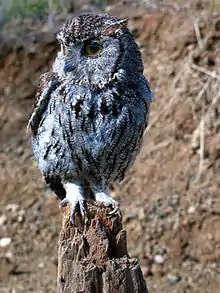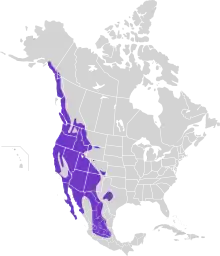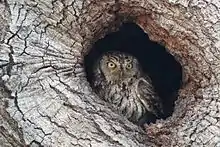Western screech owl
The western screech owl (Megascops kennicottii) is a small owl native to North and Central America, closely related to the eastern screech owl. The scientific name commemorates the American naturalist Robert Kennicott.
| Western screech owl | |
|---|---|
 | |
| Scientific classification | |
| Kingdom: | Animalia |
| Phylum: | Chordata |
| Class: | Aves |
| Order: | Strigiformes |
| Family: | Strigidae |
| Genus: | Megascops |
| Species: | M. kennicottii |
| Binomial name | |
| Megascops kennicottii (Elliot, 1867) | |
| Subspecies | |
|
See text | |
 | |
| Synonyms | |
|
Otus kennicottii | |
Description
Length averages 22 cm (8.7 in), wingspan 55 cm (22 in), and weight 143 g (5.0 oz). Weight ranges from 88 to 220 g (3.1 to 7.8 oz).[2] Females are larger than males and northern populations are notably larger than southern populations.[3] Adults are larger than whiskered screech owls, with larger feet and a more streaked plumage pattern.
There are several morphs: brown Pacific, grey Pacific, Great Plains, Mojave, and Mexican. All have either brown or dark gray plumage with streaking on the underparts. There is no red morph.
They have a round head with ear tufts, yellow eyes, and a yellowish bill. Their appearance is quite similar to whiskered and eastern screech owls, so it is best to identify them by their calls. They were previously considered to be the same species as the eastern screech owl.[4]
Call
The primary call is an accelerating series of short whistles at an increasing tempo or a short then long trill falling slightly at end. Other calls: barking and chuckling, similar to the eastern screech owl.[4] They also make a high pitched screech.
The two primary songs for the Western Screen Owl are the bounce and double trill. In a recent study, researchers utilizes sonographic analysis of tape-recorded vocalizations to analyze whether the songs differ in male and females and if so, how accurately could songs be classified by sex. It was discovered that on average, male bounce songs were ~30% lower in frequency than bounce songs of females. However, song duration, note duration, number of notes per bout, and internet duration did not differ. For trill songs, males were also significantly lower in frequency compared to those of females. In addition, female double trill songs had greater internet distances in the leading portion. [5]
Range and habitat
The western screech owl is native to Canada, United States, Mexico, Guatemala, El Salvador, Honduras, Costa Rica, and Nicaragua.[1] Its habitat includes temperate forests, subtropical and tropical montane forests, shrubland, desert, rural fields, and even suburban parks and gardens.[1]
Breeding
They are permanent residents of the northwest North and Central America, breeding in open woods, or mixed woods at forest edges. They often use holes in trees or cacti that were opened by woodpeckers.
Prey
These birds wait on perches to swoop down on unsuspecting prey; they may also catch insects in flight. They are active at dawn, night, or near dusk, using their excellent hearing and night vision to locate prey. Their diet consists mainly of small mammals such as mice or rats, birds, and large insects; however they are opportunistic predators, even taking small trout at night. Motion-activated cameras have photographed the birds eagerly scavenging a road-kill opossum. They have also been known to hunt Mallard ducks and cottontail rabbits, occasionally. Hatching of their young, usually four to five, is synchronized with the spring migration of birds; after migrants pass through screech-owls take fledglings of local birds.
Subspecies
There are 9 recognized subspecies:[6]
- Megascops kennicottii aikeni Brewster, 1891
- Megascops kennicottii bendirei (Brewster, 1882)
- Megascops kennicottii cardonensis (Huey, 1926)
- Megascops kennicottii kennicottii (Elliot, 1867)
- Megascops kennicottii macfarlanei Brewster, 1891
- Megascops kennicottii suttoni (R. T. Moore, 1941)
- Megascops kennicottii vinaceus Brewster, 1888
- Megascops kennicottii xantusi Brewster, 1902
- Megascops kennicottii yumanensis (A. H. Miller & L. Miller, 1951)
Gallery
 Captive bird at the Desert Museum
Captive bird at the Desert Museum Nest hole
Nest hole_(17026365169).jpg.webp) Perched
Perched
Notes
| Wikimedia Commons has media related to Megascops kennicottii. |
| Wikispecies has information related to Megascops kennicottii. |
- BirdLife International (2012). "Megascops kennicottii". IUCN Red List of Threatened Species. 2012. Retrieved 26 November 2013.
- CRC Handbook of Avian Body Masses by John B. Dunning Jr. (Editor). CRC Press (1992), ISBN 978-0-8493-4258-5.
- (2011).
- The Sibley Guide to Birds, by David Allen Sibley, ISBN 0-679-45122-6
- Herting, Brian L (1 October 2001). "Bounce and Double Trill Songs of Male and Female Western Screech-Owls: Characterization and Usefulness for Classification of Sex". The Auk. 118 (4): 1095. doi:10.1093/auk/118.4.1095. Retrieved 25 April 2020.
- "Megascops kennicottii". Integrated Taxonomic Information System. Retrieved 4 April 2011.

